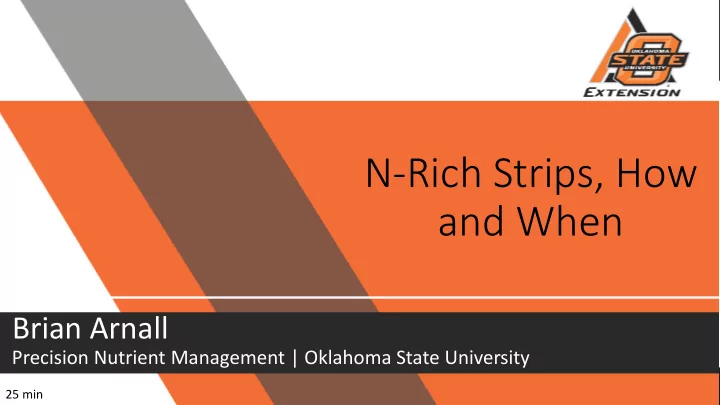

N-Rich Strips, How and When Brian Arnall Precision Nutrient Management | Oklahoma State University 25 min
Getting N right for the Year • Mobile Nutrients N • Yield and Environment Driven!! • Make determinations based off Environment and Plant measured in Season • Wheat 1.3 lbs N bu -1 • Corn .75 lbs N bu -1
Yield and Nitrogen Rate 120 Yield (bu ac-1) Economical Opt N Rate 100 80 60 40 20 0 2004 2005 2006 2007 2008 2009 2010 2011 2012 2013
Reference Strips • Are Very Visual.. • Consider 0 N
How, When, Where • Applicator and Source, BFY. • Ideal minimum size: • Width 10’ Length 300’ • Rates: 40 – 80 lbs N ac. above the field rate. CR-2277 Applying Nitrogen-Rich Strips
Applicators
How, When, Where • When: • Pre-plant / Pre emerge • 30 days Post • Prior to green-up. • Where: • Every Field | Zone | Cultivar • Representative area CR-2277 Applying Nitrogen-Rich Strips
N-Rich Strip layouts N N RS RS N-Rich Strip N N RS RS
Sensors get Get a Rate
SBNRC NUE.okstate.edu • No Specific Time to Sense • Needs Planting Date and Sensing Date • Determines Response • Predicts Yield • Provides an accurate N Rate. PSS-2278 Using the GreenSeeker Handheld Sensor and Sensor-Based Nitrogen Rate Calculator
Farmer Practice SBNRC 2009 Location Nrate Yield Protein NUE Nrate Yield Protein NUE 39 23 11.91 0.18 48 26 12.08 0.22 Site 1 36 53 13.51 0.65 49 54 13.68 0.54 Site 2 84 39 0.00 39 33 0.00 Site 3 60 52 11.69 0.28 24 44 10.66 0.12 Site 4 60 59 14.42 0.02 7 61 14.54 0.72 Site 5 60 66 11.69 0.35 38 62 10.83 0.25 Site 6 33 29 10.15 0.20 59 37 10.20 0.26 Site 7 28 42 10.26 0.48 59 48 11.12 0.41 Site 8 Averages 50 45 11.95 0.27 41 46 11.87 0.31 2010 Location Nrate Yield Protein NUE Nrate Yield Protein NUE 160 63 15.16 0.10 23 62 13.05 0.06 Site 1 60 39 12.48 0.19 49 40 12.60 0.27 Site 2 60 40 12.20 0.41 72 42 11.86 0.35 Site 3 50 91 13.57 0.12 34 91 14.25 0.39 Site 4 40 65 10.89 0.08 48 67 11.06 0.13 Site 5 50 45 15.05 0.02 12 46 14.59 0.07 Site 6 Averages 70 57 13.22 0.15 40 58 12.90 0.21 Total 59 50 12.54 0.22 40 51 12.35 0.27
Regional GreenSeeker Grain Yields - 2005 Check Farmer practice N-Rich GreenSeeker 200 180 Grain Yield (bu/ac) 160 140 120 100 80 60 40 20 0 Afton Gore Pauls Valley Webbers Falls 1 Webbers Falls 2 Choctaw County Fort Gibson Pittsburg County Quapaw South Coffeyville
Regional GreenSeeker Grain Yields - 2005 Check Farmer practice N-Rich GreenSeeker 350 300 250 Profit ($/ac) 200 150 100 50 0 Afton Gore Pauls Valley Webbers Falls 1 Webbers Falls 2 Choctaw County Fort Gibson Pittsburg County Quapaw South Coffeyville
Comparison of Sensor Based N Rec’s to Soil Test Based Rec’s, 2006 -2008 Manhattan 2006 160 155 60 33 33 27 0 Partridge 2006 48 32 42 57 55 -13 2 Tribune 2006 130 128 30 24 15 15 9 Manhattan 2007 111 109 130 98 105 25 -7 Partridge 2007 77 70 40 15 20 20 -5 Tribune 2007 71 79 54 0 0 54 0 Manhattan 2008 151 128 77 45 45 32 0 Ottawa 2008 58 64 56 55 60 -4 -5 Partridge 2008 140 123 41 30 15 26 15 Average 22.2 0.9
Average Wheat Performance 100 NS 90 80 Farme GS 7% less N with GS r 70 Practic 60 Farme GS e r 50 Practic 40 e 30 20 10 0 Grain Yield, bu/ac GS 30 N Rate Applied, lb/ac Courtesy Wade Thomason VT
Average Corn Performance NS 160 140 Farme Sensor r 120 21 % less N with GS 100 Practic Farmer e 80 Sensor Practic 60 e 40 20 0 Sidedress N, lb/ac Grain Yield, bu/ac Courtesy Wade Thomason VT
2010 Percent N Reduced Average Reduction = 25% Percent decrease in side-dress rate from farmer practice to GreenSeeker 60% Side-dress N reduction (%) 51% 50% 44% 40% 31% 30% 20% 18% 20% 10% 6% 5% 0% 1 2 3 4 5 6 7 Site N reduction with equal yields.
Clemson • Our work has shown that compared to uniform rate applications the SVNA system has the potential to reduce N usage by 30 to 70% in cotton, corn and wheat productions.
On-the Go
End Game Zone by Response
Thank you!!! Please fill out the Survey Brian Arnall 373 Ag Hall 405-744-1722 b.arnall@okstate.edu www.npk.okstate.edu Twitter: @OSU_NPK www.Facebook/ OSUNPK YouTube Channel : OSUNPK Blog : OSUNPK.com www.Aglandlease.info
Recommend
More recommend